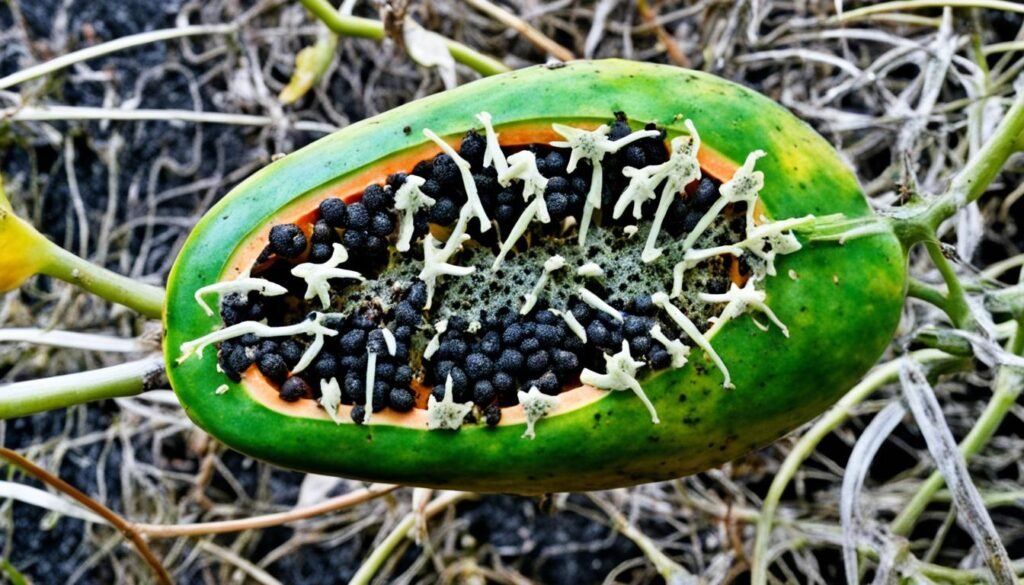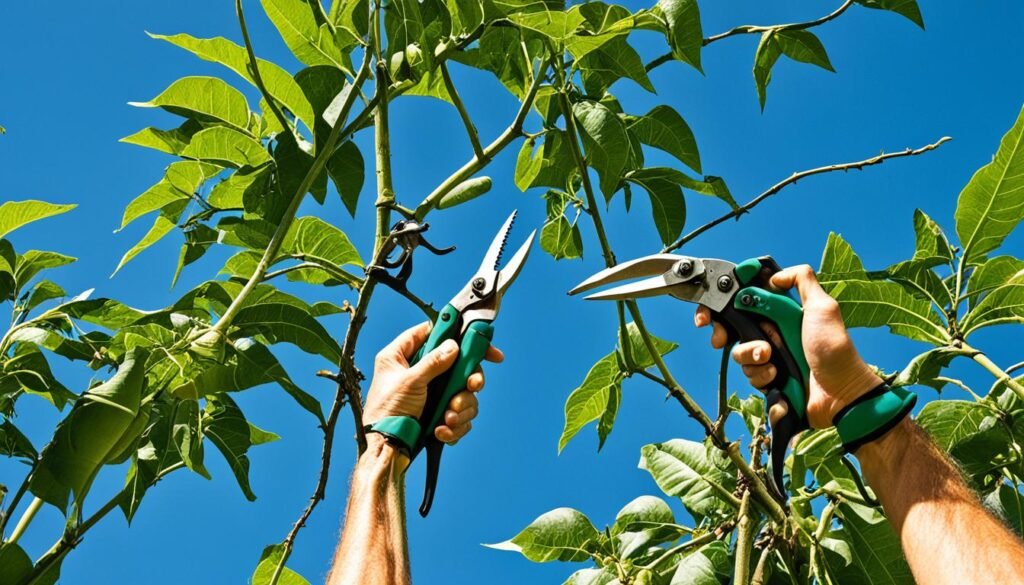Dreaming of a tropical paradise at home? I’m Sarah, and I love gardening. I wanted to grow papaya trees for their stunning looks and tasty fruit.
At a local farmer’s market, I found ripe papayas that I had to try. Their color and sweet smell drew me in. After buying some, I enjoyed their tropical taste.
I got curious about growing papayas after eating them. I looked into it and found it’s easy. Papaya trees not only provide tasty fruit but also look beautiful in a garden.
So, I got my gardening tools to grow papayas. I was eager to start my tropical oasis with the right advice and excitement.
In this article, discover how to easily grow papayas. I’ll cover picking the right kind and the perfect conditions. I’ll also help with keeping your trees healthy.
Are you ready to learn about growing papayas? Keep reading to find out how to succeed with these trees.
Choosing the Right Variety and Planting
Choosing the right type of papaya for your area is key. Different papaya types do well in certain hardiness zones. To grow papaya successfully, match the variety to your climate.
Look for varieties suited to USDA zones 9-11. These areas offer the right conditions. Papayas love warm weather all year, so they fit well in moderate climates.
You can plant papaya seeds in the ground or in big pots. But, remember, papaya trees don’t dig very deep roots. So, use soil that drains well to avoid waterlogging.
Plant your papayas where they get lots of sunlight. Full sun for most of the day is best. Sunlight is vital for making their food and for them to grow and bear fruit.
When caring for your papayas, make sure the soil stays moist. But don’t water too much, or the roots could rot. Water them regularly to keep them healthy and help the fruit grow.
Don’t forget about trimming and feeding your papaya trees. Pruning keeps them healthy and the shape nice. Fertilizing gives them the nutrients they need to grow well and produce fruit.
Providing Optimal Growing Conditions
I’ve learned that papaya trees need the right conditions to grow well. They love being in warm places with a lot of sunlight. If you live in USDA zones 9 and 10 or have a greenhouse, you’re set. The ideal temperature for papayas is between 70 and 90 degrees Fahrenheit.
Watering is key for papaya care. They like moist soil, not wet. Too much water can harm them. So, make sure the soil drains well to avoid problems. This simple step helps papayas grow healthy and strong.
Adding organic matter to the soil is also crucial. Compost or manure works great. It makes the soil better for the trees and gives them food. Using the right fertilizer is a good idea too. It adds more nutrients for papayas to grow well.
“Providing optimal growing conditions is crucial for successful papaya tree cultivation. From warm temperatures and full sun to appropriate watering and soil enrichment, these factors play a vital role in the overall health and productivity of papaya trees.”
By following these tips, farmers can help their papaya trees grow better. It’s all about warm spots, lots of sunlight, proper watering, and good soil. With these ideal conditions, papaya trees will reward growers with a lot of tasty fruit.
Managing Pests and Diseases
Papaya trees face many threats like papaya mealybug and fruit flies. They also struggle with diseases such as Phytophthora fruit rot. These issues can hurt the health and fruitfulness of your trees. So, using the right methods to control pests and diseases is key to keeping your plants safe.
Preventing infestations
To keep pests away, check your papaya trees often. Look for pests like mealybugs on the leaves and fruit. Finding them early lets you act fast to stop them from spreading.
Keep the area clean by removing fallen leaves and fruit. This makes it harder for pests to live near your trees.
Managing pests
If you spot pests, you can use special soaps and oils to get rid of them. These are safe for papayas. Follow the product’s instructions and spray the top and bottom of the leaves.
Preventing diseases
Papaya trees can get sick too, from diseases like Phytophthora fruit rot. Here’s how to stop these diseases:
- Don’t water too much. Wet conditions help diseases grow.
- Make sure the soil drains well to avoid too much water.
- Give your papayas enough space for air to move around them.
- Change where you plant your papayas to keep the soil disease-free.
Treating diseases
If your trees start to look sick, act quickly. Talk to a gardening expert to find out what’s wrong. They will help you with the right treatments.
Keeping an eye on your papaya trees and using good pest and disease techniques is vital. This will keep your trees healthy and able to produce lots of fruit.

Pollination and Fruit Development
Papaya trees rely heavily on pollination for fruit to grow. Normally, they need bees to move pollen between girl and boy trees. Yet, some types can pollinate themselves, leading to more fruit.
Female papaya trees grow better and bigger fruit than males. The fruit comes from female flowers pollenized by bees. After this happens, the fruit begins to form.
When the fruit is young, it’s green and firm. Time and care make it turn orange, with a bright pink inside. This process turns a green papaya into a sweet treat.
Papayas are not just tasty but full of good things like vitamins and antioxidants. Once ripe, they are ready to eat. This is when you can enjoy their natural flavor and health perks in many ways. Fresh slices or in meals, there’s a lot you can do with a ripe papaya.
Pruning and Propagation
Pruning and propagation are key for growing healthy papaya trees. They help the trees stay healthy and bear more fruit. While papaya trees do not need a lot of pruning, it’s good to do it when necessary.
Papayas mostly grow from one central trunk. So, you won’t often need to cut off big branches. But, if you see any branches that are damaged or sick, it’s best to cut them off. Use sharp pruners to do this. It keeps the tree healthy and stops diseases from spreading.
Planting papayas from seeds is a common way to grow them. First, make sure the seeds are clean and dry. Then, plant them in a warm, damp place. This could be a greenhouse or inside your home. This helps the seeds start growing.

After your seeds sprout and have a few leaves, you can move them to bigger pots or the ground. Use soil that drains well and make sure they get enough sun. This is crucial for their early growth.
Keep the soil around the seedlings moist. But, don’t let it get too wet. You also want to keep the air warm and humid. As the trees grow, keep an eye on them. Give them the care they need. This way, you can enjoy lots of papayas.
Harvesting and Enjoying Papaya Fruit
After a long wait, it’s time to pick your papaya fruit. Choosing the right time to harvest is very important. You need to see if they are ready and how you plan to use them.
It takes about 4 to 5 months from the flower stage for papayas to be ripe. Ripe ones are a beautiful, bright orange. This shows they are sweet and ready to eat.
But, you can also pick them when they are green. Green papayas are used in cooking, adding a special taste to dishes. They are not as soft and sweet as the ripe ones.
Want to spice up your cooking? Try green papayas in Thai papaya salad or pickled versions.
After harvest, papayas offer many tasty and healthy eating options. Eating them fresh is a great start. Their juicy, sweet flavor will make you happy.
You can also dry papayas for later. Dried papaya slices are a good snack. They keep their unique taste even when dried.
“Drying papaya not only concentrates their flavors but also allows for extended shelf life.”
Papayas can be in many dishes, from smoothies to salsas. Their mild sweet taste mixes well with other foods, creating new and tasty dishes.
Take good care of your ripe papayas to prevent damage. Keep them in a cool, dark place. This keeps them fresh for longer.
Common Questions and Troubleshooting
Starting to grow papaya may lead to questions and challenges. Let’s check two common ones: the time it takes for a papaya tree to grow from seed and how to transplant a papaya tree.
How long does it take to grow papaya from seed?
Papaya trees take around 6-9 months to fruit from seed. This timeframe can change based on many factors. Things like climate, where it’s grown, and papaya type are big influences.
Transplanting a Papaya Tree
Transplanting a big papaya tree is tough. Yet, medium-sized trees can be moved with care. Here’s how to do it well:
- Choose a new spot with good soil, sunlight, and water for your tree.
- Dig a hole big enough for the tree’s root ball in the new place.
- Pick up the tree carefully, keeping as many roots unharmed as you can.
- Plant it in the new hole, adding soil and packing it gently around the roots.
- Water the tree a lot right after transplanting. Keep taking good care of it to help it grow well in its new home.
If you still have questions or run into more problems, talk to gardening experts. Or, get in touch with your local agricultural groups. They’re great help for advice and solving tough issues with your papaya trees.
Conclusion
Learning to grow papaya can be both fun and rewarding. Make sure to give them the best setting to grow. ♦ With care and attention, you’ll see your efforts pay off with healthy trees. Following tips from the experts can lead you to a successful harvest.
Papayas offer more than tasty fruit from their tropical roots. They also bring rich benefits to your backyard. ♦ Proper care like sunlight, good soil, and water will help your trees flourish. This means more nutritious fruit for your family.
Watching for pests and diseases is key to keeping your trees healthy. ♦ Be quick to fix any problems you spot. Routine pruning and feeding, along with the right environment, will boost your trees’ growth. This care results in a plentiful yield.
0 Comments